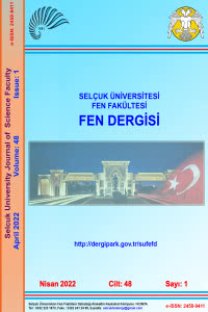COMPARISION OF INTERNATIONAL CODES FOR STEEL ANCHORS DETAILS USING IN SEISMIC STRENTHENING
Sismik Güçlendirmede Kullanılan Ankraj Detayları İçin Uluslararası Yönetmeliklerin Karşılaştırılması
___
- ACI Committee, 2014, Building Code Requirements for Structural Concrete and Commentary (ACI 318- 14), American Concrete Institute.
- Altin, S., Ersoy U., Tankut T., 1992,"Hysteretic Response of Reinforced-Concrete Infilled Frames",ASCE Journal of Structural Engineering, Vol.118(8), pp.2133-2150.
- Altin, S., Anil O., Kara E., 2008, "An Experimental Study on Reinforced Concrete Partially Infilled Frames", Engineering Structures, Vol. 29,pp.449-460.
- Anil, O., Altin, S., 2007, "An Experimental Study on Reinforced Concrete Partially Infilled Frames", Engineering Structures, Vol. 29, pp.449-460.
- Çalışkan, Ö.,Yilmaz, S., and Kaplan, H., 2011, "Güçlendirme Ankrajlarının Kesme Dayanımının ACI318 ve TS500'e Göre Belirlenmesi", Journal of Engineering Sciences, Vol. 14(3), pp. 19-27.
- Çalışkan, Ö., Yılmaz S., Kaplan H., Kıraç N., 2013, "Shear Strength of Epoxy Anchors Embedded Into Low Strength Concrete", Construction and Building Materials, Vol. 38, pp. 723-730.
- Canbay, E., Ersoy, U.,Ozcebe, G., 2003, "Contribution of Reinforced Concrete Infillsto Seismic Behavior of Structural Systems", ACI Structural Journal, Vol.100(5), pp. 637-643.
- Canbay, E., 2001, Contribution of RC Infills to The Seismic Behavior of Structural Systems, PhD Dissertation, Middle East Technical University, Ankara.
- Canbay, E., Ersoy U., Özcebe G., 2002, "Betonarme Dolgu Duvarların Yapıların Sismik Davranışı Üzerine Etkileri. Research Report No: INTAG 563", Scientific and Technical Research Council of Turkey-TUBITAK, Ankara.
- CEN, EN 1998-3:2005 Eurocode 8: Design of structures for earthquake resistance - Part 3: Assessment and retrofitting of buildings. European Committee of Standardization. Brussels.
- Erdem, I., Akyuz, U., Ersoy, U. and Ozcebe, G., 2006, "Experimental and Analytical Studies on The Strengthening of Rc Frames", 13th World Conference on Earthquake Engineering, Vancouver, Canada.
- Ersoy, U., 1992, "Repair and Strengthening of RC Structures", International Symposium on Earthquake Disaster Prevention, CENAPRED, Mexico City, pp. 123-138.
- Fardis M., Schetakis, A., Strepelias, E., 2013, "RC Buildings Retrofitted by Converting Frame Bays Into RC Walls", Bull Earthquake Eng.,Vol. 11, pp. 1541-1561.
- Gesoğlu M., Özturhan T., Özel M., Güneyişi E., 2005, "Tensile Behavior Of Post-Installed Anchors in Plain and Steel Fiber-Reinforced Normal-And High-Strength Concretes", ACI Structural Journal, Vol. 102 (2), pp. 224-231.
- Hayashi, T., Niwa, H. and Fukuhara, M., 1980, "The Strengthening Methods of the Existing Reinforced Concrete Buildings", 7th World Conference on Earthquake Engineering, Istanbul, Vol.7, pp.89-96.
- IS 15988, 2013, Seismic Evaluation and Strengthening of Existing Reinforced Concrete Buildings - Guidelines, New Delhi.
- Jirsa, J.O., 1988, "Behaviour of Epoxy-Grouted Dowels and Bolts Used for Repair of Strengthening of RC Structures", Proceedings of 9th World Conference on Earthquake Engineering, Tokyo-Kyoto, pp.371- 376, 1988.
- JCI, 2001, Standard for Seismic Evaluation of Existing Reinforced Concrete Buildings, Japan Building Disaster Prevention Association.
- Obata, M., Inoue, M., Goto, Y., 1998, "The Failure Mechanism and The Pull-Out Strength of A Bond- Type Anchor Near A Free Edge",Mechanics of Materials, Vol. 28 (1-4), pp. 113-122.
- Sonuvar, M., Ozcebe, G. and Ersoy, U., 2004, "Rehabilitation of Reinforced Concrete Frames with Reinforced Concrete Infills", ACI Structural Journal, Vol. 101 (4), pp. 494-500.
- Phan, T., Cheok, S., and Todd, R., 1996, Strengthening Methodology for Lightly Reinforced Concrete Frames: Recommended Design Guidelines for Strengthening with Infill Walls. Gaithersburg: National Institute of Standards and Technology.
- Sakla, S.S.S., Ashour, A.F., 2005,"Prediction of Tensile Capacity of Single Adhesive Anchors Using Neural Networks", Computers and Structures, Vol. 83 (21-22), pp. 1792-1803.
- Strepelias, E., Palios, X., Bousias, N. and Fardis, N., 2012, "Pseudodynamic Tests on 4-Storey Nonductile Frames with RC Infilling of The Bay", SERIES Workshop: Role of Research Infrastructures in Seismic Rehabilitation, Istanbul, 2012.
- Sugano, S., 1981, "Seismic Strengthening of Existing Reinforced Concrete Buildings in Japan", Bulletin of the New Zealand National Society for Earthquake Engineering, Vol. 14(4), pp. 371-378.
- TEC-2007, Ministry of Public Works and Settlement, Turkish Earthquake Code-2007: Specifications For Buildings to Be Built in Seismic Areas, Ankara, Turkey (in Turkish), 2007.
- TS500 Betonarme Yapıların Hesap ve Yapım Kuralları, 2000, Türk Standartları Enstitüsü, Ankara.
- Turk, M., Ersoy, U., Ozcebe, G., 2003, "Seismic Rehabilitation of RC Frames with RC Infill Walls", Fifth National Conference on Earthquake Engineering, Istanbul-Turkey, pp. 1-9, 2003.
- Yilmaz C., Aktas M., Kuyuk S., Yaman D., 2014, "Behavior of RC Frames Strengthened with Infill Panel under Dynamic Loading", Second European Conference on Earthquake Engineering and Seismology, Istanbul-Turkey, pp.861-866, 2014.
- Yilmaz S., Özen M.A., Yardim Y., 2013, "Tensile behavior of post-installed chemical anchors embedded to low strength concrete", Construction and Building Materials,Vol. 47, pp. 861-866.
- ISSN: 2147-9364
- Yayın Aralığı: 2
- Başlangıç: 2013
- Yayıncı: Selçuk Üniversitesi Mühendislik Fakültesi
COMPARISION OF INTERNATIONAL CODES FOR STEEL ANCHORS DETAILS USING IN SEISMIC STRENTHENING
MUSA HAKAN ARSLAN, Mohamud Abdirahman IBRAHIM
OKAN ÖZBAKIR, Sabri Erkin NASUF
ÇOKLU REGRESYON METODUYLA ELEKTRİK TÜKETİM TALEBİNİ ETKİLEYEN FAKTÖRLERİN İNCELENMESİ
ÇOK ÖLÇÜTLÜ KARAR VERME YÖNTEMİ VE HEDEF PROGRAMLAMA TEKNİKLERİ İLE TEDARİKÇİ SEÇİMİ
Emir Hüseyin Özder, TAMER EREN
SERPİL EDEBALİ, Havva TUTAR KAHRAMAN
Havva TUTAR KAHRAMAN, SERPİL EDEBALİ
LEACHING OF ZINC AND MANGANESE FROM SPENT ZINC-CARBON BATTERIES IN ACETIC ACID SOLUTION
